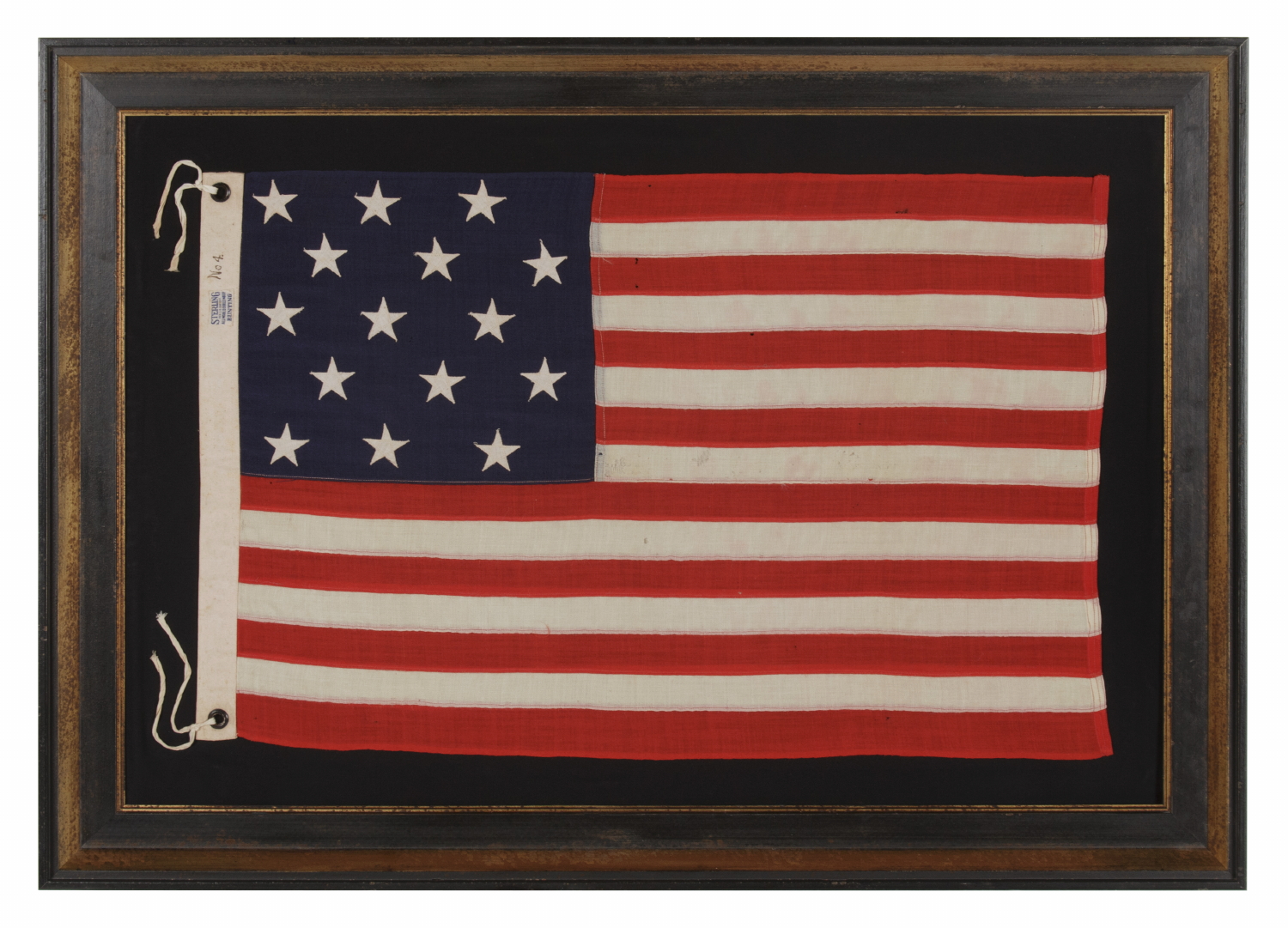
| |
15 STARS AND 15 STRIPES, A COPY OF THE STAR SPANGLED BANNER, THE FAMOUS FLAG ON WHICH FRANCIS SCOTT KEY GAZED IN BALTIMORE HARBOR WHILE WRITING THE WORDS TO THE SONG OF THE SAME NAME; THIS EXAMPLE MADE BY ANNIN & COMPANY IN NEW YORK CITY, CA 1912-14: |
|
| Available: |
Sold |
| Frame Size (H x L): |
34.25" x 47.75" |
| Flag Size (H x L): |
23.5" x 36.25" |
|
| Description....: |
|
15 star American national flag with 15 stripes, a small scale flag made by Annin & Company in New York City between roughly 1912 and 1914, to commemorate the Star Spangled Banner, the most famous surviving flag from early America. The original was a 32-foot long garrison flag, made by Mary Pickersgill in Baltimore, Maryland in the summer of 1813, during the War of 1812, and flown at Fort McHenry in Baltimore Harbor. It this flag that Francis Scott Key was gazing upon, in 1814, when he wrote the song that would become our national anthem.br />
The first flag act of 1777 provided for 13 stripes and 13 stars. When Vermont and then Kentucky became the 14th and 15th states in 1791 and 1792, respectively, there were no immediate changes to the national flag. Three years later, in 1795, the second flag act was passed by Congress, raising both the count of both the stripes and the stars to 15. This remained the official specification through the addition of five more states until finally, following the addition of Mississippi as the 20th state in 1818, the count of stars was raised again to 20. At this time the number of stripes was retuned the original 13, where it remains today almost 200 years later, to reflect the 13 original colonies.
Surviving 15 star flags that actually date to the 15 star period are extraordinarily rare. By this I mean flags dating between 1792-1796, when there were exactly 15 states, or in the official 15-star period, between 1795-1818. Approximately five examples are presently known, including the Star Spangled Banner, all of which have a complement of 15 stripes.
Other flags with 15 stars were sometimes produced outside the 1792-1818 period. Even these are extremely scarce. Some were produced during the mid-late 19th century, possibly to glorify Kentucky as the 15th state. Others, like the one in question here, were made to replicate the design of the Star Spangled banner in the early 20th century. The fact that so few exist raises their interest among collectors who wish to own a flag in this star count, irrespective of the precise period of manufacture.
This particular flag was probably made sometime between 1912 and 1914, to remember the War of 1812 and the flag that inspired our anthem. There was a rebirth of American patriotism at the time, which grew even more during WWI (U.S. involvement 1917-18), and popular design trends reflected the American Federal period (1790-1820's).
The canton and stripes of the flag are made of wool bunting and joined with machine stitching. The stars of the flag are made of cotton and are double-appliquéd (applied to both sides) with a zigzag machine stitch. There is a heavy canvas binding along the hoist with 2 brass grommets, through which lengths of herringbone twill cotton tape were threaded and tied for hositing. The flag was made by the Annin Company in New York City, as evidenced by the maker's tag along the hoist that reads: "Sterling; Reg. U.S. Pat. Off.; All Wool Double Warp Bunting." Annin is our nation's eldest flag-maker that is still in business today. The company was founded in the 1820's on the New York waterfront, incorporated in 1847, and, though it opened a large manufacturing operation in Verona, New Jersey in 1916, maintained its head office and some production in Manhattan until 1960. Sterling was an Annin brand name and represented a top-of-the-line, heavy-duty flag of especially high quality. "No. 4" also appears along the hoist, above the tag, inscribed with a dip pen. This denotes a numeric size identification.
The scale of the flag is tiny, even among flags of this period. During most of the 19th century, flags with pieced-and-sewn construction were typically 8 feet long and larger. A 6-foot flag was generally considered small. In the 1890's flag-makers began to offer smaller flags in larger quantities. These almost universally had 13 stars and generally measured either 2 x 3 or 2.5 x 4 feet. There were few exceptions until the 48 star period, and even then 48 star examples with pieced-and-sewn construction that survive today are fairly scarce in 3 or 4 foot lengths, prior to WWII.
Measuring approximately 2 x 3 feet, this extremely small flag is ideal for ease of framing and display, which is coveted by collectors.
Mounting: The flag has been hand-stitched to 100% natural fabrics for support on every seam and throughout the star field. It was then hand-sewn to a background of 100% cotton twill, black in color, that was washed to reduce excess dye. An acid-free agent was added to the wash to further set the dye and the fabric was heat-treated for the same purpose. The mount was then placed in a black-painted, hand-gilded and distressed Italian molding. The glazing is U.V. protective plexiglass.
Condition: There is extremely minor mothing and extremely minor staining. Absolutely excellent for a flag of this period. |
|
|
|
| Collector Level: |
Intermediate-Level Collectors and Special Gifts |
|
| Flag Type: |
Sewn flag |
|
| Star Count: |
15 |
|
| Earliest Date of Origin: |
1912 |
|
| Latest Date of Origin: |
1914 |
|
| State/Affiliation: |
Kentucky |
|
| War Association: |
|
|
| Price: |
SOLD |
|
| |
Views: 3432 |
|
|
|

